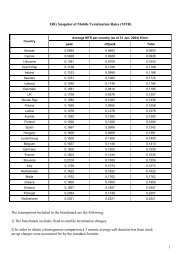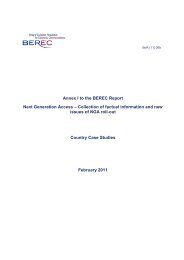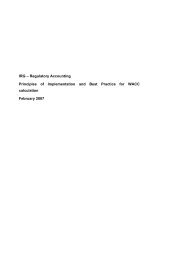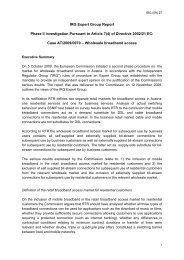16 Rev2b NGA Opinion Supplementary doc - IRG
16 Rev2b NGA Opinion Supplementary doc - IRG
16 Rev2b NGA Opinion Supplementary doc - IRG
You also want an ePaper? Increase the reach of your titles
YUMPU automatically turns print PDFs into web optimized ePapers that Google loves.
ERG (07) <strong>16</strong>rev2b <strong>NGA</strong> <strong>Opinion</strong> <strong>Supplementary</strong> Doc 31 / 69<br />
It exists also a demand from new entrants to use internal cabling of apartments building to<br />
provide VDSL services from DSLAM installed in the basement of the buildings with fibre or<br />
leased line access. BIPT has launched a consultation to determine the best way to process<br />
such usage; a first consultation about a full unbundling at the level of the building distribution<br />
frame has proved that is not feasible (too complex).<br />
VDSL2 is included in markets 11 and 12 in market analysis; backhaul SDH and Ethernet is<br />
imposed in market 13 up to the street cabinet.<br />
2.3 France<br />
Situation of DSL<br />
In the last years, most of operators focused on DSL technology to increase bandwidth access<br />
on the existing incumbent copper local loop. Currently ADSL2+ offers up to 24 Mbps<br />
downstream and up to 1 Mbps upstream bandwidth. Thanks to the bitrates available with<br />
DSL technology, internet service providers have been able to launch their triple play offers at<br />
the end of 2003. Currently, from a total broadband market of 14.25 million customers, 13.55<br />
million use DSL and 700 000 use cable.<br />
Introduction of VDSL2 technology on France Télécom’s local loop, at the level of the street<br />
cabinet, is still under study in France. Theoretically, VDSL2 may deliver up to 70 Mbps downstream.<br />
However, no operator so far has announced any FttCab (Fibre to the Cabinet) deployment.<br />
One of the reasons seems to be that France Télécom’s sub loop is too long, in<br />
average, compared to the situation in Germany or the Netherlands, so that greater bandwidth<br />
may not be attainable for a great part of the population.<br />
FttH announcement<br />
In 2006, the three main French DSL operators, France Télécom, Free and Neuf Cegetel,<br />
announced their plans to roll out their own FttH (Fibre to the Home = new optical local loop)<br />
networks in Paris and in the main cities. So far, alternative fibre rolls out in the local loop only<br />
concerned business customers with MAN deployed in the main cities.<br />
Actually, regarding announcements made by alternative operators (Free and Neuf Cegetel),<br />
it appears that there is an opportunity, considering their market shares in the main cities, to<br />
shift from a LLU model to an asset-based model, climbing up to the last row of the ladder of<br />
investments by rolling out their own local loop. In particular, possibility to access to alternative<br />
infrastructures in Paris, the sewing systems, enabling them to roll out their own fibre cables<br />
till each buildings, has to be taken into account in those moves.<br />
France Télécom:<br />
- 270M€ till 2008 / 3 to 4,5 billions € till 2012<br />
- deployments under process in Paris, Lille, Lyon, Toulouse, Poitiers, Marseille<br />
- technology used: GPON<br />
- … so as to massively reuse its own ducts inherited from the former monopoly<br />
Free:<br />
- <strong>16</strong>0M€ till 2008 / 1 billion € till 2012<br />
- bought Citefibre (former FttH operator) in September 2006







